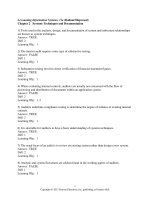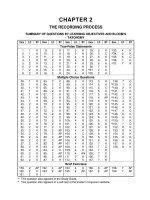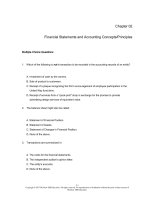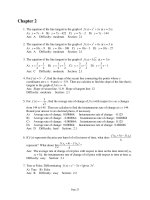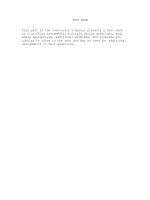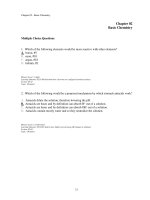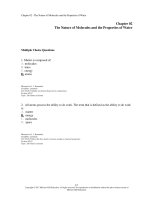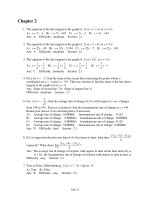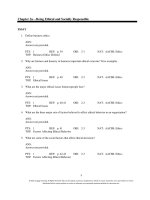Corporate finance 11th edition ross test bank
Bạn đang xem bản rút gọn của tài liệu. Xem và tải ngay bản đầy đủ của tài liệu tại đây (1.37 MB, 98 trang )
Chapter 03
1. Projected future financial statements are called:
A. plug statements.
B. pro forma statements.
C. reconciled statements.
D. aggregated statements.
E. comparative statements.
2. The extended version of the percentage of sales method:
A. assumes that all net income will be paid out in dividends to stockholders.
B. assumes that all net income will be retained by the firm and offset by a reduction in debt.
C. is based on a capital intensity ratio of 1.0.
D. requires that all financial statement accounts change at the same rate.
E. separates accounts that vary with sales from those that do not vary with sales.
3. Which statement expresses all accounts as a percentage of total assets?
A. pro forma balance sheet
B. common-size income statement
C. statement of cash flows
D. pro forma income statement
E. common-size balance sheet
4. Ratios that measure a firm's ability to pay its bills over the short run without undue stress are
known as:
A. asset management ratios.
B. long-term solvency measures.
C. liquidity measures.
D. profitability ratios.
E. market value ratios.
5. The current ratio is measured as:
A. current assets minus current liabilities.
B. current assets divided by current liabilities.
C. current liabilities minus inventory, divided by current assets.
D. cash on hand divided by current liabilities.
E. current liabilities divided by current assets.
6. The quick ratio is measured as:
A. current assets divided by current liabilities.
B. cash on hand plus current liabilities, divided by current assets.
C. current liabilities divided by current assets, plus inventory.
D. current assets minus inventory, divided by current liabilities.
E. current assets minus inventory minus current liabilities.
7. Ratios that measure a firm's financial leverage are known as ________ ratios.
A. asset management
B. long-term solvency
C. short-term solvency
D. profitability
E. market value
8. The debt-equity ratio is measured as:
A. total equity divided by long-term debt.
B. total equity divided by total debt.
C. total debt divided by total equity.
D. long-term debt divided by total equity.
E. total assets minus total debt, divided by total equity.
9. The equity multiplier is measured as total:
A. equity divided by total assets.
B. equity plus total debt.
C. assets minus total equity, divided by total assets.
D. assets plus total equity, divided by total debt.
E. assets divided by total equity.
10. Ratios that measure how efficiently a firm uses its assets to generate sales are known as
_______ ratios.
A. asset management
B. long-term solvency
C. short-term solvency
D. profitability
E. market value
11. The inventory turnover ratio is measured as:
A. total sales minus inventory.
B. inventory times total sales.
C. cost of goods sold divided by inventory.
D. inventory divided by cost of goods sold.
E. inventory divided by sales.
12. The financial ratio days' sales in inventory is measured as:
A. inventory turnover plus 365 days.
B. inventory times 365 days.
C. inventory plus cost of goods sold, divided by 365 days.
D. 365 days divided by the inventory.
E. 365 days divided by the inventory turnover.
13. The receivables turnover ratio is measured as:
A. sales plus accounts receivable.
B. sales divided by accounts receivable.
C. sales minus accounts receivable, divided by sales.
D. accounts receivable times sales.
E. accounts receivable divided by sales.
14. The total asset turnover ratio measures the amount of:
A. total assets needed for every $1 of sales.
B. sales generated by every $1 in total assets.
C. fixed assets required for every $1 of sales.
D. net income generated by every $1 in total assets.
E. net income than can be generated by every $1 of fixed assets.
15. Ratios that measure how efficiently a firm's management uses its assets and equity to generate
bottom line net income are known as _______ ratios.
A. asset management
B. long-term solvency
C. short-term solvency
D. profitability
E. market value
16. The financial ratio measured as net income divided by sales is known as the firm's:
A. profit margin.
B. return on assets.
C. return on equity.
D. asset turnover.
E. earnings before interest and taxes.
17. The measure of net income returned from every dollar invested in total assets is the:
A. profit margin.
B. return on assets.
C. return on equity.
D. asset turnover.
E. earnings before interest and taxes.
18. The financial ratio that measures the accounting profit per dollar of book equity is referred to as
the:
A. profit margin.
B. price-earnings ratio.
C. return on equity.
D. equity turnover.
E. market profit-to-book ratio.
19. The amount that investors are willing to pay for each dollar of annual earnings is reflected in the:
A. return on assets.
B. return on equity.
C. debt-equity ratio.
D. price-earnings ratio.
E. DuPont identity.
20. The market-to-book ratio is measured as the:
A. market price per share divided by the par value per share.
B. net income per share divided by the market price per share.
C. market price per share divided by the net income per share.
D. market price per share divided by the dividends per share.
E. market value per share divided by the book value per share.
21. The external funds needed (EFN) equation projects the addition to retained earnings as:
A. PM × Δ Sales.
B. PM ×Δ Sales× (1 - d).
C. PM × Projected sales × (1 - d).
D. Projected sales × (1 - d).
E. PM ×Projected sales.
22. Which one of the following statements is correct concerning ratio analysis?
A. A single ratio is often computed differently by different individuals.
B. Ratios do not address the problem of size differences among firms.
C. Only a very limited number of ratios can be used for analytical purposes.
D. Each ratio has a specific formula that is used consistently by all analysts.
E. Ratios cannot be used for comparison purposes over periods of time.
23. Which one of the following is a liquidity ratio?
A. quick ratio
B. cash coverage ratio
C. total debt ratio
D. EV multiple
E. times interest earned ratio
24. An increase in which one of the following accounts increases a firm's current ratio without
affecting its quick ratio?
A. accounts payable
B. cash
C. inventory
D. accounts receivable
E. fixed assets
25. A supplier, who requires payment within ten days, should be most concerned with which one of
the following ratios when granting credit?
A. current
B. cash
C. debt-equity
D. quick
E. total debt
26. A firm has a total debt ratio of .47. This means the firm has 47 cents in debt for every:
A. $1 in total equity.
B. $.53 in total assets.
C. $1 in current assets.
D. $.53 in total equity.
E. $1 in fixed assets.
27. The long-term debt ratio is probably of most interest to a firm's:
A. credit customers.
B. employees.
C. suppliers.
D. mortgage holder.
E. stockholders.
28. A banker considering loaning money to a firm for ten years would most likely prefer the firm have
a debt ratio of _______ and a times interest earned ratio of _______.
A. .50; .75
B. .50; 1.00
C. .45; 1.75
D. .40; .75
E. .40; 1.75
29. From a cash flow position, which one of the following ratios best measures a firm's ability to pay
the interest on its debts?
A. times interest earned ratio
B. cash coverage ratio
C. cash ratio
D. quick ratio
E. interval measure
30. The higher the inventory turnover, the:
A. less time inventory items remain on the shelf.
B. higher the inventory as a percentage of total assets.
C. longer it takes a firm to sell its inventory.
D. greater the amount of inventory held by a firm.
E. lesser the amount of inventory held by a firm.
31. Which one of the following statements is correct if a firm has a receivables turnover of 10?
A. It takes the firm 10 days to collect payment from its customers.
B. It takes the firm 36.5 days to sell its inventory and collect the payment from the sale.
C. It takes the firm an average of 36.5 days to sell its items.
D. The firm collects on its sales in an average of 36.5 days.
E. The firm has ten times more in accounts receivable than it does in cash.
32. A capital intensity ratio of 1.03 means a firm has $1.03 in:
A. total debt for every $1 in equity.
B. equity for every $1 in total debt.
C. sales for every $1 in total assets.
D. total assets for every $1 in sales.
E. long-term assets for every $1 in short-term assets.
33. Puffy's Pastries generates five cents of net income for every $1 in equity. Thus, Puffy's has
_______ of 5 percent.
A. a return on assets
B. a profit margin
C. a return on equity
D. an EV multiple
E. a price-earnings ratio
34. If a firm produces a return on assets of 15 percent and also a return on equity of 15 percent, then
the firm:
A. has no debt of any kind.
B. is using its assets as efficiently as possible.
C. has no net working capital.
D. also has a current ratio of 15.
E. has an equity multiplier of 2.
35. If stockholders want to know how much profit the firm is making on their entire investment in that
firm, the stockholders should refer to the:
A. profit margin.
B. return on assets.
C. return on equity.
D. equity multiplier.
E. earnings per share.
36. Assume BGL Enterprises increases its operating efficiency by lowering its costs while holding its
sales constant. As a result, given all else constant, the:
A. return on equity will increase.
B. return on assets will decrease.
C. profit margin will decline.
D. equity multiplier will decrease.
E. price-earnings ratio will increase.
37. Joe's has old, fully depreciated equipment. Moe's just purchased all new equipment which will be
depreciated over eight years. If Joe’s and Moe’s have the same sales, costs, tax rate, and
enterprise value, then:
A. Joe's will have a lower profit margin.
B. Joe's will have a lower return on equity.
C. Moe's will have a higher net income.
D. Moe's and Joe’s will have the same EV multiple.
E. Moe's will have a lower EV multiple.
38. Last year, Alfred's Automotive had a price-earnings ratio of 15 and earnings per share of $1.20.
This year, the price earnings ratio is 18 and the earnings per share is $1.20. Based on this
information, it can be stated with certainty that:
A. the price per share decreased.
B. the earnings per share decreased.
C. investors are paying a lower price per share this year as compared to last year.
D. investors are receiving a higher rate of return this year.
E. the investors’ outlook for the firm has improved.
39. Turner's Inc. has a price-earnings ratio of 16. Alfred's Co. has a price-earnings ratio of 19. Thus,
you can state with certainty that one share of stock in Alfred's:
A. has a higher market price than one share of stock in Turner's.
B. has a higher market price per dollar of earnings than does one share of Turner's.
C. sells at a lower price per share than one share of Turner's.
D. represents a larger percentage of firm ownership than does one share of Turner's stock.
E. earns a greater profit per share than does one share of Turner's stock.
40. Which one of the following is most apt to cause a firm to have a higher price-earnings ratio?
A. slow industry outlook
B. very low current earnings
C. low market share
D. low prospect of firm growth
E. low investor opinion of firm
41. Vinnie's Motors has a market-to-book ratio of 3.4. The book value per share is $34 and earnings
per share are $1.36. Holding the market-to-book ratio and earnings per share constant, a $1
increase in the book value per share will:
A. decrease the price-earnings ratio.
B. decrease the EV multiple.
C. decrease the market price per share.
D. increase the price-earnings ratio.
E. increase the return on equity.
42. Which one of the following sets of ratios would generally be of the most interest to stockholders?
A. return on assets and profit margin
B. quick ratio and times interest earned
C. price-earnings ratio and debt-equity ratio
D. return on equity and price-earnings ratio
E. cash coverage ratio and equity multiplier
43. The DuPont identity can be computed as:
A. Net income × Profit margin × (1 + Debt-equity ratio).
B. Profit margin × (1 / Capital intensity) × (1 + Debt-equity ratio).
C. Net income × Total asset turnover × Equity multiplier.
D. Profit margin × Total asset turnover × Debt-equity ratio.
E. Return on equity × Profit margin × Total asset turnover.
44. If a firm decreases its operating costs, all else constant, then the:
A. profit margin will decrease.
B. return on assets will decrease.
C. total asset turnover rate will increase.
D. cash coverage ratio will decrease.
E. price-earnings ratio will decrease.
45. It is easier to evaluate a firm using its financial statements when the firm:
A. is a conglomerate.
B. is global in nature.
C. uses the same accounting procedures as other firms in its industry.
D. has a different fiscal year than other firms in its industry.
E. tends to have one-time events such as asset sales and property acquisitions.
46. The most effective method of directly evaluating the financial performance of a firm is to compare
the financial ratios of the firm to:
A. the firm’s ratios from prior time periods and to the ratios of firms with similar operations.
B. the average ratios of all firms within the same country over a period of time.
C. those of other firms located in the same geographic area that are similarly sized.
D. the average ratios of the firm’s international peer group.
E. those of the largest conglomerate that has operations in the same industry as the firm.
47. In the financial planning model, the external financing needed (EFN) as shown on a pro forma
balance sheet is equal to the changes in assets:
A. plus the changes in liabilities minus the changes in equity.
B. minus the changes in both liabilities and equity.
C. minus the changes in liabilities.
D. plus the changes in both liabilities and equity.
E. minus the change in retained earnings.
48. The least problem encountered when comparing the financial statements of one firm with those of
another firm occurs when the firms:
A. are in different lines of business.
B. have geographically diverse operations.
C. use different methods of depreciation.
D. are both classified as conglomerates.
E. have the same fiscal year-end.
49. The maximum rate at which a firm can grow while maintaining a constant debt-equity ratio is best
defined by its:
A. rate of return on assets.
B. internal rate of growth.
C. average historical rate of growth.
D. rate of return on equity.
E. sustainable rate of growth.
50. The sustainable growth rate will be equivalent to the internal growth rate when, and only when,:
A. a firm has no debt.
B. the growth rate is positive.
C. the plowback ratio is positive but less than 1.
D. a firm has a debt-equity ratio equal to 1.
E. the retention ratio is equal to 1.
51. The sustainable growth rate:
A. assumes there is no external financing of any kind.
B. is normally higher than the internal growth rate.
C. assumes the debt-equity ratio is variable.
D. is based on receiving additional external debt and equity financing.
E. assumes the dividend payout ratio is equal to zero.
52. If a firm bases its growth projection on the rate of sustainable growth, shows positive net income,
and has a dividend payout ratio of 30 percent, then the:
A. fixed assets will have to increase at the same rate, even if the firm is currently operating at only
78 percent of capacity.
B. number of common shares outstanding will increase at the same rate of growth.
C. debt-equity ratio will have to increase.
D. debt-equity ratio will remain constant while retained earnings increase.
E. fixed assets, the debt-equity ratio, and number of common shares outstanding will all increase.
53. Marcie's Mercantile wants to maintain its current dividend policy, which is a payout ratio of 35
percent. The firm does not want to increase its equity financing but is willing to maintain its
current debt-equity ratio. Given these requirements, the maximum rate at which Marcie's can
grow is equal to:
A. 35 percent of the internal rate of growth.
B. 65 percent of the internal rate of growth.
C. the internal rate of growth.
D. the sustainable rate of growth.
E. 65 percent of the sustainable rate of growth.
54. One of the primary weaknesses of many financial planning models is that they:
A. rely too much on financial relationships and too little on accounting relationships.
B. are iterative in nature.
C. ignore the goals and objectives of senior management.
D. ignore cash payouts to stockholders.
E. ignore the size, risk, and timing of cash flows.
55. Financial planning, when properly executed:
A. ignores the normal restraints encountered by a firm.
B. is based on the internal rate of growth.
C. reduces the necessity of daily management oversight of the business operations.
D. ensures internal consistency among the firm’s various goals.
E. eliminates the need to plan more than one year in advance.
56. A public firm's market capitalization is equal to the:
A. total book value of assets less book value of debt.
B. par value of common equity.
C. price per share multiplied by number of shares outstanding.
D. firm's stock price multiplied by the number of shares authorized.
E. the maximum value an acquirer would pay for the firm in an acquisition.
57. Enterprise value is based on the:
A. market value of interest bearing debt plus the market value of equity minus cash.
B. book values of debt and assets, other than cash.
C. market value of equity plus the book value of total debt minus cash.
D. book value of debt plus the market value of equity.
E. book values of debt and equity less cash.
58. The equity multiplier measures:
A. financial leverage.
B. returns to stockholders.
C. operating efficiency.
D. management efficiency.
E. asset use efficiency.
59. The return on equity can be calculated as:
A. ROA × Equity multiplier.
B. Profit margin × ROA.
C. Profit margin × ROA × Total asset turnover.
D. ROA ×(Net income / Total assets).
E. ROA × Debt-equity ratio.
60.
Which one of the following depicts a correct relationship?
A.
Dividend payout ratio = 1 – Retention ratio
B.
Total asset turnover = 1 + Capital intensity ratio
C.
ROA = ROE × (1 + Debt-equity ratio)
D.
ROE = 1 – ROA
E.
Equity multiplier = 1 – Debt-equity ratio
61.
Which account is least apt to vary directly with sales?
A.
notes payable
B.
inventory
C.
cost of goods sold
D.
accounts payable
E.
accounts receivable
62. A firm has sales of $22,400, net income of $3,600, net fixed assets of $18,700, inventory of
$2,800, and total current assets of $6,300. What is the common-size statement value of
inventory?
A. 10.07%
B. 13.67%
C. 11.20%
D. 12.50%
E. 9.84%
63. A firm has sales of $38,900, net income of $2,400, total assets of $43,100, and total equity of
$24,700. Interest expense is $830. What is the common-size statement value of the interest
expense?
A. 2.13%
B. 3.08%
C. 1.93%
D. 2.49%
E. 3.46%
64. Jessica's Boutique has cash of $218, accounts receivable of $457, accounts payable of $398,
and inventory of $647. What is the value of the quick ratio?
A. .55
B. 1.05
C. 1.70
D. 1.32
E. 1.52
65. Browning’s has a debt-equity ratio of .47. What is the equity multiplier?
A. 1.47
B. .53
C. 2.13
D. 1.13
E. 1.53
66. Cado Industries has total debt of $6,800 and a debt-equity ratio of .36. What is the value of the
total assets?
A. $18,889
B. $24,480
C. $23,520
D. $25,689
E. $25,360
67. Wybro’s Markets has sales of $684,000, costs of $437,000, interest paid of $13,800, total assets
of $712,000, and depreciation of $109,400. The tax rate is 35 percent and the equity multiplier is
1.6. What is the return on equity?
A. 11.30%
B. 13.92%
C. 7.06%
D. 15.48%
E. 18.08%
68. Rosita's Resources paid $11,310 in interest and $16,500 in dividends last year. The times
interest earned ratio is 2.9, the depreciation expense is $7,900, and the tax rate is 35 percent.
What is the value of the cash coverage ratio?
A.
3.71
B.
2.58
C.
3.60
D.
2.78
E.
3.10
69. Home Systems has sales of $312,800, cost of goods sold of $218,400, inventory of $46,300, and
accounts receivable of $62,700. How many days, on average, does it take the firm to both sell its
inventory and collect payment on the sale?
A. 142.10
B. 96.37
C. 178.21
D. 150.54
E. 124.03
70. Northern Industries has accounts receivable of $42,300, inventory of $61,200, sales of $544,200,
and cost of goods sold of $393,500. How many days, on average, does it take the firm to sell its
inventory?
A. 93.08
B. 74.92
C. 85.14
D. 56.77
E. 80.46
71. Two Sisters Dresses has net working capital of $43,800, net fixed assets of $232,400, net income
of $43,900, and current liabilities of $51,300. The tax rate is 35 percent and the profit margin is
9.3 percent. How many dollars worth of sales are generated from every $1 in total assets?
A. $1.44
B. $1.32
C. $1.73
D. $.97
E. $1.06
72. Uptowne Restaurant has sales of $418,000, total equity of $224,400, a tax rate of 34 percent, a
debt-equity ratio of .37, and a profit margin of 5.1 percent. What is the return on assets?
A. 6.93%
B. 9.50%
C. 11.08%
D. 7.13%
E. 13.13%
73. Sun Shade’s has sales of $363,000, total assets of $323,500, and a profit margin of 14.6 percent.
The firm has a total debt ratio of 54 percent. What is the return on equity?
A. 28.45%
B. 35.61%
C. 23.29%
D. 31.74%
E. 7.88%
74. Discount Mart has $876,400 in sales. The profit margin is 3.8 percent. There are 32,500 shares of
stock outstanding. The market price per share is $21.60. What is the price-earnings ratio?
A. 23.40
B. 22.60
C. 19.21
D. 21.08
E. 18.47
75. New Metals has depreciation of $28,300, interest expense of $11,400, EBIT of $62,700, a priceearnings ratio of 8.6, a profit margin of 7.2 percent, a tax rate of 34 percent, and 37,500 shares of
stock outstanding. What is the market price per share?
A. $3.48
B. $5.09
C. $7.76
D. $12.48
E. $9.92
76. A firm has 12,000 shares of stock outstanding, sales of $638,100, a profit margin of 8.2 percent, a
tax rate of 35 percent, a price-earnings ratio of 11.3, and a book value per share of $7.98. What is
the market-to-book ratio?
A. 6.08
B. 5.42
C. 5.16
D. 6.17
E. 6.90
77. Preston Woods has 17,500 shares of stock outstanding along with $408,000 of interest bearing
debt. The market and book values of the debt are the same. The firm has sales of $697,000 and
a profit margin of 6.8 percent. The tax rate is 35 percent, the debt-equity ratio is 40 percent, and
the price-earnings ratio is 11.8. The firm has $130,000 of current assets of which $41,200 is cash.
What is the enterprise value multiple?
A. $1,106,308
B. $994,520
C. $830,479
D. $1,018,097
E. $926,073
78. Frederico's has a net income of $29,600, a total asset turnover of 1.4, total assets of $318,600,
and a debt-equity ratio of .35. What is the return on equity?
A. 16.72%
B. 8.40%
C. 12.54%
D. 14.67%
E. 17.56%
79. Samuelson's has sales of $317,000, a profit margin of 8.6 percent, an equity multiplier of 1.8, and
total debt of $144,400. What is the return on equity?
A. 15.48%
B. 14.46%
C. 7.05%
D. 15.10%
E. 11.25%
80. A firm has a return on equity of 16.2 percent, a debt-equity ratio of 44 percent, a capital intensity
ratio of 1.08, a current ratio of 1.25, and current assets of $138,000. What is the profit margin?
A. 12.15%
B. 9.72%
C. 7.48%
D. 15.19%
E. 13.69%
81.
What is the current ratio for 2015?
A. 1.95
B. .95
C. 2.06
D. 1.98
E. .98
82.
What are the days' sales in inventory for 2015? (Use ending inventory)
A.
61.84 days
B.
62.79 days
C. 67.51 days
D. 42.97 days
E. 40.08 days
83.
What is the equity multiplier for 2015?
A. 1.48
B. 1.28
C. 1.66
D. 2.13
E. 2.99
84.
What is the cash coverage ratio for 2015?
A. 11.06
B.
6.02
C.
13.79
D.
14.89
E.
8.78
85.
What are the values of the three components of the DuPont identity for 2015?
A. 7.91%; 1.0248; 1.4806
B. 8.57%; 1.0248; .6754
C. 7.91%; .9758; 1.4806
D. 11.43%; .9758; .6754
E. 11.43%; 1.0248; 1.4806
